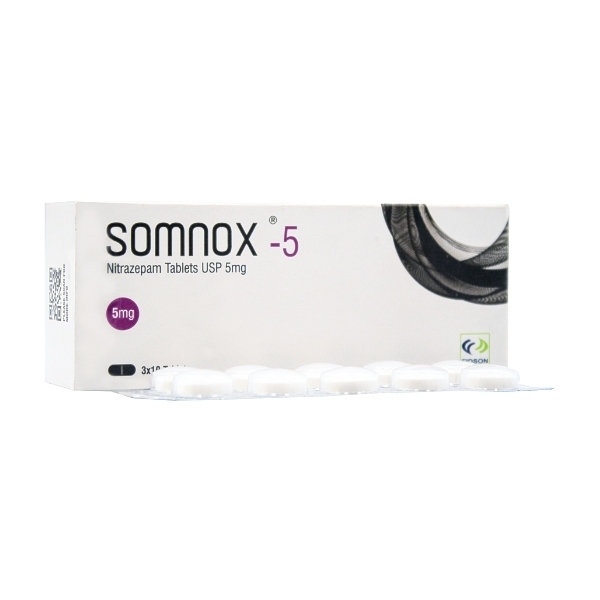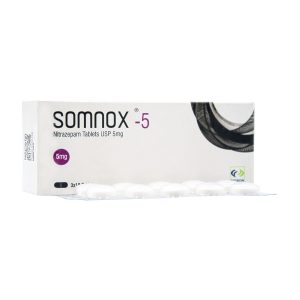Read this leaflet carefully before you start taking this medicine. (DOWNLOAD)
Description
Somnox is a benzodiazepine sedative and hypnotic agent, has the chemical formula 1,3-Dihydro-7-nitro-5-phenyl-2H-1,4- benzodiazepin-2-one. Its structural formula is:
C15H11N3O3 MW: 281.271
Pharmacokinetic properties
Somnox is fairly readily absorbed from the GI tract, although there is some individual variation. It is extensively bound to plasma proteins. It is metabolised in the liver, mainly by nitro-reduction and acetylation (which is reported to be subject to genetic polymorphism). It is excreted in the urine in the form of metabolites with only small amounts of a dose appearing unchanged. Up to about 20% of an oral dose is found in the faeces. It crosses the placental barrier and traces are found in breast milk.
Indication
Somnox is indicated for the short-term treatment of insomnia only when it is severe, disabling, or subjecting the individual to extreme stress and where daytime sedation is acceptable.
Contraindication
- Known hypersensitivity to benzodiazepines and any other ingredients in the tablets
- Phobic or obsessional states; chronic psychosis
- Acute pulmonary insufficiency; respiratory depression (ventilatory failure may be exacerbated)
- Myasthenia gravis (condition may be exacerbated)
- Sleep apnea (condition may be exacerbated)
- Severe hepatic insufficiency (elimination half-life of nitrazepam may be prolonged)
- Acute porphyria
Warnings
The drug should be kept at 150C-300C in a tightly closed container.
Precautions
An underlying cause should be sought before deciding upon the use of benzodiazepines for symptomatic relief.
- Tolerance – Tolerance to their effects develops within 3-14 days of continuous use and hence treatment regimens should be kept to a minimum and repeat prescriptions avoided. Limits of tolerance in patients with organic cerebral changes (particularly resulting from arteriosclerosis) or cardiorespiratory insufficiency may be very wide; care must be taken in adapting the dosage with such patients.
- Dependence and Withdrawal – Withdrawal symptoms occur with benzodiazepines following normal therapeutic doses given for short periods of time.
Use of nitrazepam may lead to the development of physical and psychological dependence. The risk of dependence increases with the dose and duration of treatment, and in patients with a history of alcoholism and drug abuse.
Once physical dependence has developed, abrupt termination of treatment will be accompanied by withdrawal symptoms.
- Rebound insomnia: a transient syndrome whereby the symptoms that led to treatment with nitrazepam may recur in an enhanced form on withdrawal of treatment. It may be accompanied by other reactions including mood changes, anxiety or sleep disturbances and restlessness. Since the risk of withdrawal phenomena/rebound phenomena is greater after abrupt discontinuation of treatment, it is recommended that the dosage is decreased gradually.
- Duration of Treatment: The duration of treatment should be as short as possible depending on the indication, but should not exceed 4 weeks including tapering off process. Treatment should not continue beyond 4 weeks without re-evaluation of the patient’s condition. Where long-term therapy is essential, it is recommended that the patient’s requirements be reviewed on a regular basis.
It may be useful to inform the patient when treatment is started that it will be of limited duration and to explain precisely how the dosage will be progressively decreased. Moreover it is important that the patient should be aware of the possibility of rebound phenomena, thereby minimising anxiety over such symptoms should they occur while nitrazepam is being discontinued. Care is needed when switching from long acting benzodiazepines, such as nitrazepam, to a benzodiazepine with a short duration of action due to the risk of withdrawal symptoms developing.
- Amnesia:Nitrazepam may induce anterograde amnesia. The condition occurs most often several hours after ingesting the product and therefore to reduce the risk patients should ensure that they will be able to have uninterrupted sleep of 7-8 hours.
- In cases of loss or bereavement, psychological adjustment may be inhibited by benzodiazepines.
- Care should be taken in patients with chronic renal or hepatic disease (elimination half-life of nitrazepam may be prolonged).
- Hypoalbuminaemia (may predispose patient to higher incidence of sedative side effects).
- Care should be exercised in prescribing nitrazepam for patients with a history of alcoholism or drug abuse as these patients are predisposed to habituation and dependence. Regular monitoring in such patients is essential. Alcohol should be avoided during treatment with nitrazepam (additive CNS depression).
- Depression or anxiety associated with depression. Benzodiazepines should not be used alone in the treatment of depression or anxiety associated with depression as suicide may be precipitated in such patients.
- Extreme caution should be used in prescribing nitrazepam to patients with personality disorders.
- Care should be exercised in patients with epilepsy since there have been reports of rare paradoxical exacerbation of seizures in these patients.
* Psychiatric and paradoxical reactions: Reactions like restlessness, agitation, irritability, aggressiveness, delusion, rages, nightmares, hallucinations, psychoses, inappropriate behaviour and other adverse behavioural effects are known to occur when using benzodiazepines. They may be quite severe and are more likely in children and the elderly. Should they occur, use of the medicinal product should be discontinued.
* Specific patient groups: Benzodiazepines should not be given to children without careful assessment of the need to do so; the duration of treatment must be kept to a minimum. The elderly should be given a reduced dose.
- Benzodiazepines are not recommended for the primary treatment of psychotic illness.
- Patients with rare hereditary problems of galactose intolerance, the Lapp lactase deficiency or glucose-galactose malabsorption should not take this medicine.
Usage in pregnancy/lactation
An increased risk of congenital malformations in humans has been associated with its use, particularly in the first and second trimesters. If the product is prescribed to a woman of childbearing potential, she should be warned to contact her physician regarding stopping if she intends to become or suspects she may be pregnant.
If the product is prescribed to a woman of childbearing potential, she should be warned to contact her physician regarding discontinuation of the product if she intends to become or suspects that she is pregnant.
If, for compelling medical reasons, the product is administered during the late phase of pregnancy, or during labour at high doses, effects on the neonate, such as hypothermia, hypotonia and moderate respiratory depression, can be expected, due to the pharmacological action of the compound.
Moreover, infants born to mothers who took benzodiazepines chronically during the latter stages of pregnancy may have developed physical dependence and may be at some risk for developing withdrawal symptoms in the postnatal period.
Since benzodiazepines are found in the breast milk, benzodiazepines should not be given to breast feeding mothers
Dosage and method of administration
Dosage
The lowest effective dose should be employed, and treatment should, if possible, be intermittent. Dosage regimes should not extend beyond 4 weeks and treatment should gradually be withdrawn. Patients who have received benzodiazepines for a long time may require an extended withdrawal period. Long-term chronic use is not recommended.
Adults: 5mg before going to bed. This dose may be increased, if necessary, up to 10mg.
Elderly and debilitated patients: 2.5-5mg before going to bed.
Children: Not recommended for children under 12 years of age.
Method of Administration: For oral administration.
Side effects
Ataxia, drowsiness, lethargy, hallucination, nausea, constipation, amnesia, confusion, light headedness, mood changes, muscle cramp, excessive salivation, somnolence.
Adverse reactions
Clumsiness or unsteadiness, dizziness, dry mouth, false sense of well-being, increased watering of the mouth, lightheadedness, and vivid dreams
Symptoms of Overdose/treatment
As with other benzodiazepines overdose would not be life-threatening unless it is combined with other CNS-depressants (including alcohol).
When treating overdosage with any drug, it should be borne in mind that several substances may be taken.
Symptoms: Overdose with benzodiazepines is normally seen accompanied by different degrees of depression of the central nervous system, which may vary from lethargy to coma. In mild cases the symptoms include lethargy, mental confusion and drowsiness, and in more serious cases the symptoms include ataxia, hypotonia, hypotension, bradycardia, breathing difficulties, in rare cases coma and in very rare cases death.
Management: Consider activated charcoal in adults or children who have taken more than 1mg/kg within 1 hour, provided they are not too drowsy. Gastric lavage is unnecessary if these drugs have been taken alone. Patients who are asymptomatic at four hours are unlikely to develop symptoms. Institute supportive measures as indicated by the patient’s clinical state.
If CNS depression is severe consider the use of flumazenil, a benzodiazepine antagonist. This should rarely be required. It has a short half-life (about an hour) and should not be used in mixed overdose or as a “diagnostic” test. Flumazenil is contraindicated in the presence of drugs that reduce seizure threshold (e.g. tricyclic antidepressants).
Possible drug interactions
- Cimetidine, oral contraceptives, disulfiram, fluoxetine, isoniazid, ketoconazole, metoprolol, propoxephene, propranolol, and valproic acid: Elimination of nitrazepam decreased due to inhibition of hepatic metabolism leading to enhanced activity.
- Alcohol & other CNS depression: Enhanced CNS Effects.
- Digoxin: Increase in serum concentration of digoxin.
- Levodopa: Decrease in antiparkinsonism efficacy.
- Imipramine & Desipramine: Enhanced activity of these drugs.
- Aminophylline: Antagonises the sedative effect.
- Rifampicin: Decreases efficacy.
- Ranitidine: Decreases GI absorption of nitrazepam.
PRESENTATION: 3×10 tablets.






